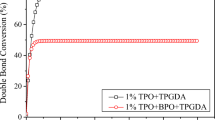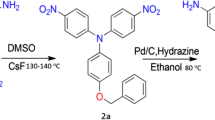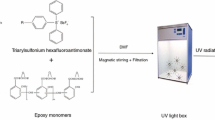Abstract
New benzothiadiazole-based long-wavelength organic dyes (Y-1 and Y-2) were prepared for effectively sensitizing diphenyliodonium hexafluorophosphate (IOPF) to initiate the fast curing of bisphenol-A epoxy resin (E51) under visible light, avoiding traditional UV light sources that have high energy and high radiation. Y-1 and Y-2 have absorption spectra extended to more than 550 nm. By using Y-1 and Y-2 as photosensitizers for IOPF, E51 reach high epoxy conversions of 95% under light wavelength of 470-nm irradiation. IOPF and benzothiadiazole dyes present at the same time show good visible-light initiating activity. The high curing conversions are attributed to the photoelectron transfer reaction between diphenyliodonium hexafluorophosphate and benzothiadiazole dyes, based on our photochemical and electrochemical experiments. In addition, the terminated groups or of Y-1 (–F) and Y-2 (–OCH3) have a great influence on the photopolymerization rate of the curing systems and thermal properties of E51 after cured. In addition, E51 was even polymerized about 70% in the presence of 510-nm light filter.






Similar content being viewed by others
References
Pintossi D, Iannaccone G, Colombo A, Bella F, Välimäki M, Väisänen KL, Hast J, Levi M, Gerbaldi C, Dragonetti C, Turri S, Griffini G (2016) Luminescent downshifting by photo-induced sol-gel hybrid coatings: accessing multifunctionality on flexible organic photovoltaics via ambient temperature material processing. Adv Electron Mater 2:1600288
Kuang X, Zhao Z, Chen K, Fang D, Kang G, Qi HJ (2018) High-speed 3D printing of high-performance thermosetting polymers via two-stage curing. Macromole Rapid Commun 39:1700809
Ravi P, Wright J, Shiakolas PS, Welch TR (2019) Three-dimensional printing of poly(glycerol sebacate fumarate) gadodiamide-poly(ethylene glycol) diacrylate structures and characterization of mechanical properties for soft tissue applications. J Bio Mater Res B 107:664–671
Li Z, Wang C, Qiu W, Liu R (2019) Antimicrobial thiol-ene-acrylate photosensitive resins for DLP 3D printing. Photochem Photobiol 95:1219–1229
Cheng Q, Zheng Y, Wang T, Sun D, Lin R (2020) Yellow resistant photosensitive resin for digital light processing 3D printing. J Appl Polym Sci 137:48369
Chen Z, Wang X, Li S, Liu S, Miao H, Wu S (2019) Near-infrared light driven photopolymerization based on photon upconversion. ChemPhotoChem 3:1077–1083
Kitano H, Ramachandran K, Bowden NB, Scranton AB (2013) Unexpected visible-light-induced free radical photopolymerization at low light intensity and high viscosity using a titanocene photoinitiator. J Appl Polym Sci 128:611–618
Ge X, Ye Q, Song L, Misra A, Spencer P (2015) Visible-light initiated free-radical/cationic ring-opening hybrid photopolymerization of methacrylate/epoxy: polymerization kinetics, crosslinking structure, and dynamic mechanical properties. Macromol Chem Phys 216:856–872
Corrigan N, Yeow J, Judzewitsch P, Xu J, Boyer C (2019) Seeing the light: advancing materials chemistry through photopolymerization. Angew Chem Int Ed 58:5170–5189
Dressano D, Palialol AR, Xavier TA, Braga RR, Oxman JD, Watts DC, Marchi GM, Lima AF (2016) Effect of diphenyliodonium hexafluorophosphate on the physical and chemical properties of ethanolic solvated resins containing camphorquinone and 1-phenyl-1,2-propanedione sensitizers as initiators. Dent Mater 32:756–764
Sari E, Mitterbauer M, Liska R, Yagci Y (2019) Visible light induced free radical promoted cationic polymerization using acylsilanes. Prog Org Coat 132:139–143
Corakci B, Hacioglu SO, Toppare L, Bulut U (2013) Long wavelength photosensitizers in photoinitiated cationic polymerization: the effect of quinoxaline derivatives on photopolymerization. Polymer 54:3182–3187
Fang B, Jin M, Wu X, Zhang Y, Wan D (2016) Near UV–vis LED-excitable two-branched sensitizers for cationic, radical, and thiol-ene photopolymerizations. Dyes Pigments 126:54–61
Mokbel H, Dumur F, Raveau B, Morlet-Savary F, Simonnet-Jégat C, Gigmes D, Toufaily J, Hamieh T, Fouassier JP, Lalevée J (2016) Perovskites as new radical photoinitiators for radical and cationic polymerizations. Tetrahedron 72:7686–7690
Shen W, Wang L, Cao Y, Zhang L, Yang Z, Yuan X, Yang H, Jiang T, Chen H (2019) Cationic photopolymerization of liquid crystalline epoxide in mesogenic solvents and its application in polymer-stabilized liquid crystals. Polymer 172:231–238
Golaz B, Michaud V, Leterrier Y, Månson JAE (2012) UV intensity, temperature and dark-curing effects in cationic photo-polymerization of a cycloaliphatic epoxy resin. Polymer 53:2038–2048
Liu X, Guo J, Sun J, Gu X, Feng W, Liu W, Li H, Zhang S (2019) The preparation of a bisphenol A epoxy resin based ammonium polyphosphate ester and its effect on the char formation of fire resistant transparent coating. Prog Org Coat 129:349–356
Musa A, Alamry KA, Hussein MA (2019) The effect of curing temperatures on the thermal behaviour of new polybenzoxazine-modified epoxy resin. Polym Bull. https://doi.org/10.1007/s00289-019-03026-0
Selvi M, Devaraju S, Alagar M (2019) Cyclotriphosphazene nanofiber-reinforced polybenzoxazine/epoxy nanocomposites for low dielectric and flame-retardant applications. Polym Bull 76:3785–3801
Liu G, Zhu X, Xu B, Qian X, Song G, Nie J (2013) Cationic photopolymerization of bisphenol A diglycidyl ether epoxy under 385 nm. J Appl Polym Sci 130:3698–3703
Morita Y (2005) Cationic polymerization of hydrogenated bisphenol-A glycidyl ether with cycloaliphatic epoxy resin and its thermal discoloration. J Appl Polym Sci 97:1395–1400
Wang T, Wang ZH (2005) Cationic photopolymerization of epoxy systems initiated by cyclopentadien-iron-biphenyl hexafluorophosphate ([Cp-Fe-biphenyl]+PF6−). Polym Bull 53:323–331
Abadie MJM, Chia NK, Boey F (2002) Cure kinetics for the ultraviolet cationic polymerization of cycloliphatic and diglycidyl ether of bisphenol-A(DGEBA) epoxy systems with sulfonium salt using an auto catalytic model. J Appl Polym Sci 86:1587–1591
Vabrik R, Czajlik I, Túry G, Rusznák I, Ille A, Víg A (1998) A study of epoxy resin–acrylated polyurethane semi-interpenetrating polymer networks. J Appl Polym Sci 68:111–119
Chen Y, Jia X, Wang M, Wang T (2015) A synergistic effect of a ferrocenium salt on the diaryliodonium salt-induced visible-light curing of bisphenol-A epoxy resin. RSC Adv 5:33171–33176
Wang M, Ma X, Yu J, Jia X, Han D, Zhou T, Yang J, Nie J, Wang T (2015) Aromatic amine-sulfone/sulfoxide conjugated D–π–A–π-D-type dyes in photopolymerization under 405 nm and 455 nm laser beams. Polym Chem 24:4424–4435
Schmitz C, Halbhuber A, Keil D, Strehmel B (2016) NIR-sensitized photoinitiated radical polymerization and proton generation with cyanines and LED arrays. Prog Org Coat 100:32–46
Huang H, Chen H, Long J, Wang G, Tan S (2016) Novel D–A–π–A organic dyes based on 3-dimensional triarylamine and benzothiadiazole derivatives for high-performance dye-sensitized solar cells. J Power Sources 326:438–446
Li F, Chen Y, Zong X, Qiao W, Fan H, Liang M, Xue S (2016) New benzothiadiazole-based dyes incorporating dithieno[3,2-b:2′,3′-d]pyrrole (DTP) π-linker for dye-sensitized solar cells with different electrolytes. J Power Sources 332:345–354
Pathaka A, Tomera T, Thomas KRJ, Fan MS, Ho KC (2019) Fine tuning the absorption and photovoltaic properties of benzothiadiazole dyes by donor-acceptor interaction alternation via methyl position. Electrochim Acta 304:1–10
Fernandes SSM, Pereira A, Ivanou D, Mendes A, Raposo MMM (2018) Benzothiadiazole derivatives functionalized with two different (hetero)aromatic donor groups: synthesis and evaluation as TiO2 sensitizers for DSSCs. Dyes Pigments 151:89–94
Li M, An C, Pisula W, Müllen K (2018) Cyclopentadithiophene-benzothiadiazole donor − acceptor polymers as prototypical semiconductors for high-performance field-effect transistors. Acc Chem Res 51:1196–1205
Wang N, Chen Z, Wei W, Jiang Z (2013) Performance polymer solar cells without any processing additives or post-treatments. J Am Chem Soc 135:17060–17068
Wang J, Chen Y, Li F, Zong X, Guo J, Sun Z, Xue S (2016) A new carbazole-based hole-transporting material with low dopant content for perovskite solar cells. Electrochim Acta 210:673–680
Ahn M, Kim MJ, Wee KR (2019) Electron push–pull effects in 3,9-bis(p-(R)-diphenylamino)perylene and constraint on emission color tuning. J Org Chem 84:12050–12057
Woon KL, Nadiah ZN, Hasan ZA, Ariffin A, Chenc SA (2016) Tuning the singlet-triplet energy splitting by fluorination at 3,6 positions of the 1,4-biscarbazoylbenzene. Dyes Pigments 132:1–6
Chen W, Zhang S, Dai G, Chen Y, Li M, Zhao X, Chen Y, Chen L (2019) Tuning the photophysical properties of symmetric squarylium dyes: investigation on the halogen modulation effects. Chem Eur J 25:469–473
Tan YL, Liang M, Lu ZY, Zheng YQ, Tong XL, Sun Z et al (2014) Novel triphenylamine donors with carbazole moieties for organic sensitizers toward cobalt(II/III) redox mediators. Org Lett 16:3978–3981
Ignatenko VY, Ilyin SO, Kostyuk AV, Bondarenko GN, Antonov SV (2019) Acceleration of epoxy resin curing by using a combination of aliphatic and aromatic amines. Polym Bull. https://doi.org/10.1007/s00289-019-02815-x
Liu R, Xu Y, Jia J, Chen P, Zhang F, Zhang L, Chen Y (2020) Improvement on curing performance and morphology of E5I/TPGDA mixture in a free radical-cationic hybrid photopolymerization system. J Polym Res 27:166
Acknowledgements
The authors wish to thank Tianjin University of Technology Municipal College Students Innovation and Entrepreneurship Training Program Subsidy Project (201810060068) and the National Natural Science Foundation of China (21506164).
Author information
Authors and Affiliations
Corresponding author
Additional information
Publisher's Note
Springer Nature remains neutral with regard to jurisdictional claims in published maps and institutional affiliations.
Electronic supplementary material
Below is the link to the electronic supplementary material.
Rights and permissions
About this article
Cite this article
Liu, R., Xu, Y., Wang, L. et al. Visible light-induced cationic photopolymerization by diphenyliodonium hexafluorophosphate and benzothiadiazole dyes. Polym. Bull. 78, 4849–4862 (2021). https://doi.org/10.1007/s00289-020-03345-7
Received:
Revised:
Accepted:
Published:
Issue Date:
DOI: https://doi.org/10.1007/s00289-020-03345-7




